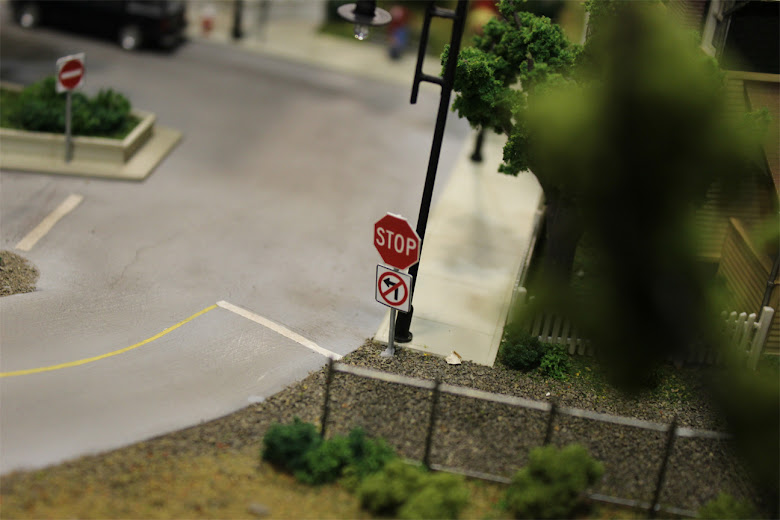Structurally, I think everything is done. I try to find things to add, or
even modify, however find that quite often more is definitely not better.
Details on the other hand, there can never be enough of those, so I will be
looking into further detailing, including figures, wildlife, foliage, etc.
Vehicles and rolling stock also still need to be added. I have done a little
experimenting with weathering trains, though I will unquestionably need more
practice at this point before I start on anything worth any significant
value. Acquiring HO scale vehicles also seems to still be quite
difficult.
I finally got to test my newest locomotive: the USRA Light Mikado 2-8-2 by
Broadway Limited. This model is Canadian National road number 3725 and
features the factory integrated Paragon2 DC/DCC dual mode decoder. This is a
big advantage for me, being that my layout is a DC layout and I can finally
enjoy the benefits of DCC sound, though quite limited on DC
tracks.
The model itself is beautifully detailed and has many separately applied
details such as ladders, handrails, whistle, brass bell and engineer and
fireman figures. Along with the locomotives 1lb weight, the 5-pole can motor
with skew wound armature ensures ultra-smooth operation right from
startup.
With a slow throttle increase from 0, the locomotive begins to produce the
same startup sounds it would make as it builds up steam pressure. With a bit
more throttle, the engine begins to slowly roll forward, all with
accompanying sound effects. As it begins to gain speed, the valve and piston
sounds increase accordingly. Slowing down the locomotive activates brake
sounds. The key here is SLOW throttle movement. This will produce the most
realistic operation under DC control.
Of course using a DCC system unlocks all the sounds and features which
include:
- Record and play operation
- 16-bit sample rate for exceptional sound
- Whistle, horn and bell sounds
- Johnson bar sound
- Ambient sounds for passenger station, freight yard, lumber yard, maintenance yard, and farm scenes.
- Grade crossing signal sounds
- Forward/reverse signal sounds
- Chuff sound that changes in intensity based on load size
- Individually adjustable sound effect volume
DC users can purchase the DCMaster by Broadway Limited to unlock the
horn/whistle and bell as well as adjust several other features. The DCMaster
works with all BlueLine, Paragon2 and Paragon 3 series engines. DCMaster is
not required for startup, brake and chuff sounds when using a DC
system.
For a sample of the Light Mikado in action on my layout, see the video
below. Note: I do not have a DCMaster system installed so the sound effects
shown are the limited defaults that active with a basic DC throttle.
I haven’t had much opportunity to work on my layout this last month, but in
the time I have had, I’ve dedicated it mostly to adding scenic details.
These details include traffic signs, additional foliage, figures, and
vehicles. It is amazing the amount of detail products readily available by
dozens of different manufacturers, and really comes down to just deciding
which products to use to achieve your desired look and level of
detail.
Traffic and street were next on the list. I couldn’t seem to find
commercially-made signs that offered the style I was looking for, so I
turned to creating my own. I found high-resolution sign images online and
used Adobe Photoshop to scale them down to a prototypical size. Most
provinces/states have online traffic standard manuals posted online which I
found useful for sizing. I printed the signs out on 5x7 photo paper at
Walmart then cut each sign out and glued it to a thin sheet of styrene for
extra rigidity. I trimmed the styrene right to the edge of each sign with
sharp scissors, keeping them nice and tidy.
My latest detail was a small woodland Scenics tool shed die-cast kit which
I installed into the turn-table yard. This small structure is highly
detailed and comes with several separate tools and details which I used
elsewhere on my layout. Other details I added were small benches that I
purchased off eBay and wooden pallets from a local hobby shop. I added a
small pile of scrap rail and lumber right behind the work shed and used
unwanted spare plastic wheels on the turn-table spurs to represent a
locomotive repair area.





































